#jeffreygibsonbkm
Photo




"The myth of disappearing Native peoples is very strong in the United States. Indigenous communities are seen by non-Native audiences as part of a historic and past frontier that now only exists in archives, museums, and libraries. We don't often learn how this stereotype of disappearance is the result of state and government policies of forced Indigenous removal, forced assimilation (through boarding schools), and the process of termination (legally erasing Native nations from existing). Art, literature, and films made by non-Native peoples policed the boundaries of what could be seen as ‘authentic’ Native culture and exported ideas of Indigenous ‘disappearance’ globally, perpetuating damaging stereotypes to this day.
Showcasing museum objects that non-Native audiences rarely see, like the 20th century Seminole dress or Haudenosaunee beaded caps on view in this exhibition, challenges viewers to think about Native presence and production long after the colonial and ‘frontier’ eras. Pairing these items with garments and headgear crafted by Jeffery Gibson reminds audiences that Native arts, culture, and community remain present to this day and demands that we expand the boundaries of what constitutes Indigenous material. Put into the same space, viewers are invited to confront their assumptions about Native history and art, see historic collections with fresh eyes, and consider how contemporary artists and Native communities are in productive dialogue with their past and future." — Dr. Christian Ayne Crouch
In observance of National Native American Heritage Month, this November we’ll be exploring the themes of the exhibition When Fire Is Applied to a Stone It Cracks, with commentary from both Jeffrey Gibson and historian Dr. Christian Ayne Crouch.
Installation views, Jeffrey Gibson: When Fire Is Applied to a Stone It Cracks, Brooklyn Museum, February 14, 2020 - January 10, 2021
#jeffreygibsonbkm#native american heritage month#nahm#native#indigenous#united states#stereotype#disappearnce#termination#native culture#seminole dress#jeffrey gibson#Dr. Christian Ayne Crouch#colonial#frontier#art#culture#native communities#history#contemporary
3K notes
·
View notes
Video
youtube
For the exhibition When Fire Is Applied to a Stone It Cracks, Jeffrey Gibson, an artist of Choctaw and Cherokee descent, collaborated with historian Dr. Christian Ayne Crouch to select a wide range of works from the Museum's holdings of Native American art, American art, and photography, as well as the Brooklyn Museum Library Special Collections and Archives. Displayed alongside Gibson’s own artwork—including the painting that gives the show its title—the historic objects underline that Indigenous art has always been modern, innovative, and global. In observance of National Native American Heritage Month this November we'll be exploring the themes of this exhibition with commentary from both Jeffrey Gibson and Dr. Crouch.
Video by Anne Sofie Nørskov, Joanne Leonhardt Cassullo Video Fellow, produced by Rachel Lewis
#jeffreygibsonbkm#jeffrey gibson#brooklyn museum#brooklyn#nyc#exhibitions#art#museums#artist#national native american heritage month#native american heritage month#nahm
177 notes
·
View notes
Photo
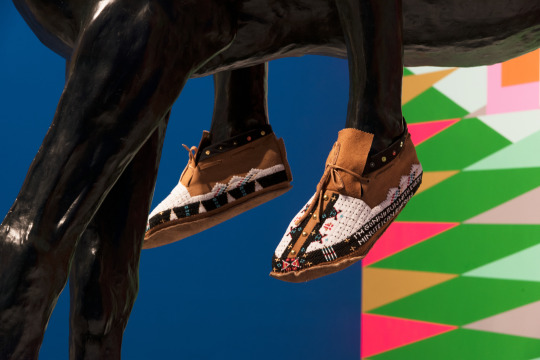

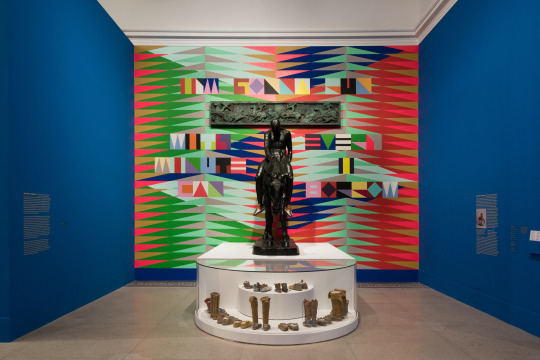
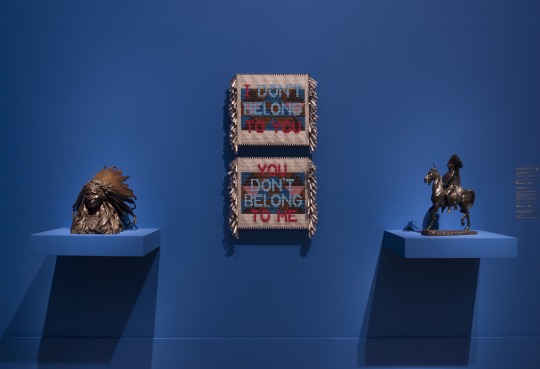
"Moccasins are often compared to our western and Eurocentric perception of shoes which are produced for the masses. This could not be further from the truth when speaking about moccasins. In order for a pair to be made, historically, the animal would have been sacrificed as part of a community event, possibly ceremonial, thanks and prayers would be given for both the animal and the wearer, and the remainder of the animal would have been used for food, and/or additional clothing for those who need it. The moccasins are made for a specific individual, there is no standard sizing. The designs are not just decorations but are often meant to identify the individual and where they come from, sometimes also to ask ancestors for protection.
Moccasins could not be more specific, whereas the bronze statues are composites of ‘Indians’ even if based on the modeling of an actual person. They are theatrical representations of the artist's perception of Native people and also western culture's fantasies, desires and fears of Native people. Positioning the sculptures and objects in context of the other is meant to draw attention to individuals and communities representing themselves versus someone representing someone else incorrectly." —Jeffrey Gibson
In observance of National Native American Heritage Month, this November we’ll be exploring the themes of the exhibition When Fire Is Applied to a Stone It Cracks, with commentary from both Jeffrey Gibson and historian Dr. Christian Ayne Crouch.
Installation views, Jeffrey Gibson: When Fire Is Applied to a Stone It Cracks, Brooklyn Museum, February 14, 2020 - January 10, 2021
#nahm#native american heritage month#jeffrey gibson#jeffreygibsonbkm#moccasins#shoes#animal#sacrifice#community#ceremonial#sizing#fashion#protection#ancestors#theatrical#brooklyn museum#native americans#indigenous#indigenous artists#art#artist#contemporary art
178 notes
·
View notes
Photo


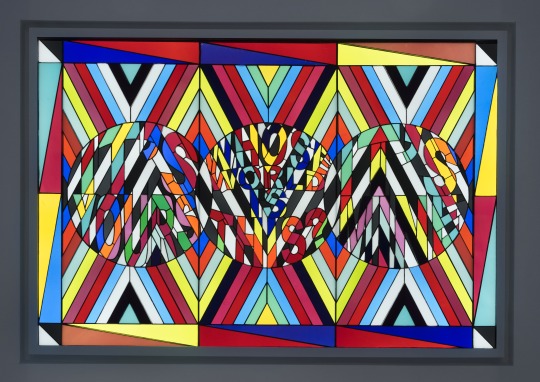

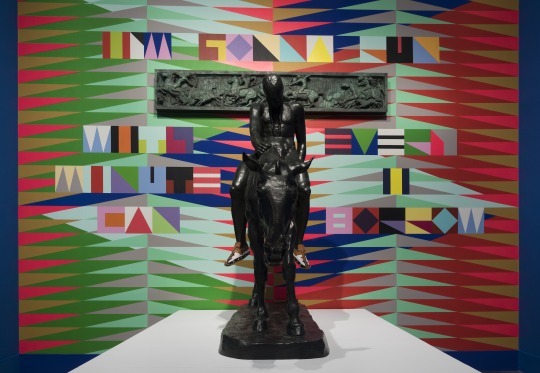
Through the combination of collection objects and his own work, artist Jeffrey Gibson’s When Fire Is Applied to a Stone It Cracks encourages visitors to rethink long-held preconceptions about “Native American art” and notions of monolithic cultural identity. For centuries, museums and other educational and cultural institutions have collected art and recounted the stories of communities and cultures without their direct input. In a decisive break with this practice, the Brooklyn Museum invited Gibson to tell his own story as an artist of Native American descent, through his work and investigation of the museum’s holdings as well as his commentaries and those co-authored with historian Dr. Christian Ayne Crouch. Visually striking and intellectually provocative, When Fire Is Applied to a Stone It Cracks is an original and innovative project: inviting a more expansive narrative that includes and integrates the histories of Indigenous people and challenging visitors to reconsider their assumptions of what Native American art can be.
Now in it’s final weekend, see this perspective-shifting exhibition before it closes this Sunday, January 10.
Installation details and views: Jeffrey Gibson: When Fire Is Applied to a Stone It Cracks, Brooklyn Museum, February 14, 2020 - January 10, 2021 #JeffreyGibsonBKM
#jeffreygibsonbkm#jeffrey gibson#native american art#brooklyn museum#brooklyn#new york city#nyc#museums#art#artist#indigenous art
62 notes
·
View notes
Photo


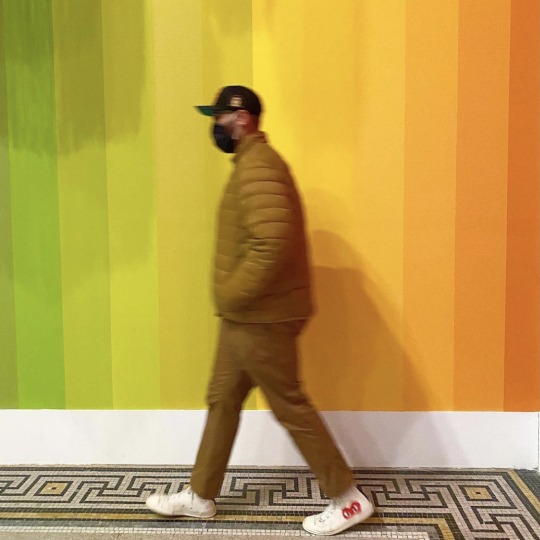



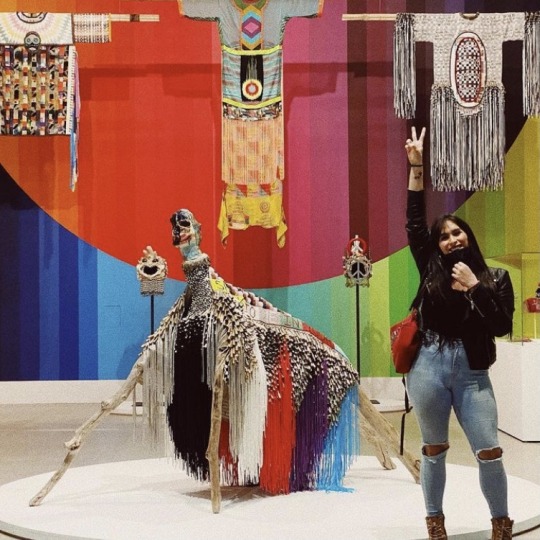

This weekend is your very last chance to visit a fan favorite of ours, Jeffrey Gibson: When Fire Is Applied to a Stone It Cracks. Make sure to stop by and bid the exhibition farewell before it closes on Sunday, January 10.
Don’t forget to tag your photos with #mybkm for a chance to be featured like recent visitors @erkuml @everette @msgigggles @caffetti_ @sherrickayvette @dancingonglass86 @amonaaaay @immadisonblack @dominthematrix #JeffreyGibsonBKM
60 notes
·
View notes
Photo



"Global Indigenous art is always evolving and innovating. I have looked to these histories for inspiration and to learn technique, and in the process have been awestruck at the innovation in both technique and material usage. The experience has given me a lot of freedom to break away from other's perceptions of what is considered to be traditional and/or Indigenous. It has also provided me with an education about history and how cultures have interacted, for better or worse, and how those interactions surface in the things made by Indigenous people. I hope my practice builds on all of this and I feel responsible to push all of it forward to represent the time that I live in." —Jeffrey Gibson
In observance of National Native American Heritage Month, this November we’ll be exploring the themes of the exhibition When Fire Is Applied to a Stone It Cracks, with commentary from both Jeffrey Gibson and historian Dr. Christian Ayne Crouch.
Installation views, Jeffrey Gibson: When Fire Is Applied to a Stone It Cracks, Brooklyn Museum, February 14, 2020 - January 10, 2021
#nahm#jeffreygibsonbkm#native american heritage month#indigenous#indigenous art#innovative#black history month#technique#material#jeffrey gibson#brooklyn museu#history#culture
66 notes
·
View notes
Photo
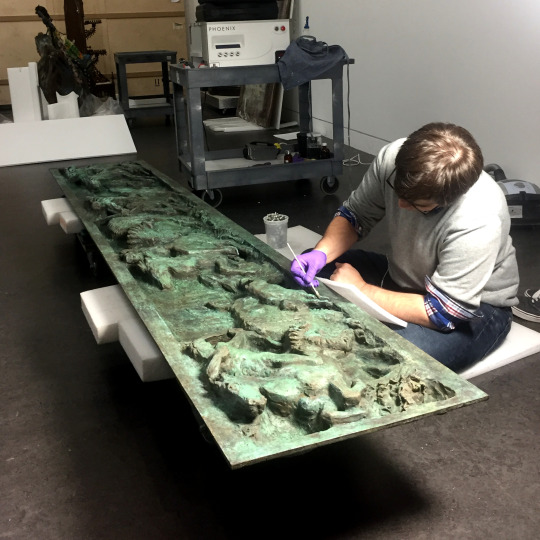
In preparation for its display in Jeffrey Gibson: When Fire Is Applied to a Stone It Cracks at Brooklyn Museum, the bronze relief of Charles Rumsey’s Study for Buffalo Hunt needed to be cleaned. It had previously been displayed for years outdoors. It was covered in a thick layer of wax and resin applied over decades as protection. The coatings had turned brown and absorbed dirt. Wax and resin were no longer necessary since they were not original and the object would be indoors. However, the coatings had become impossible to remove except with extremely harsh chemicals like paint stripper. Using a special laser, however, it was possible to remove this coating without dangerous solvents. The old, dark coating is on the left, the cleaned surface on the right.
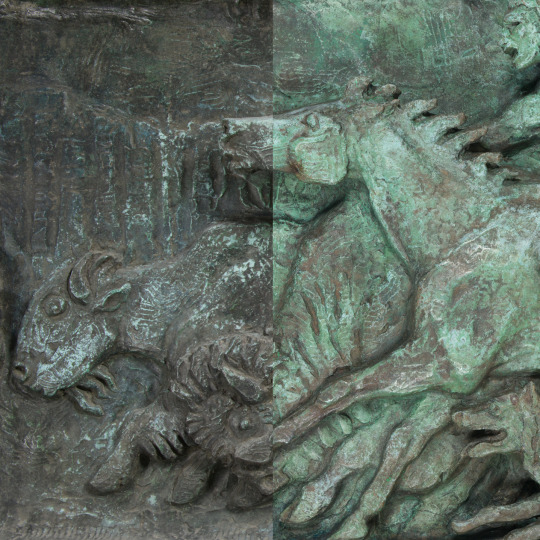
Posted by Harry DeBauche
#bkmconservation#jeffreygibsonbkm#charles rumsey#clearning#art#science#art conservation#laser#solvents#resin#wax#art museums
67 notes
·
View notes
Photo



If you’re looking for an inspiring and safe way to ring in 2021, might we suggest a few thought-provoking exhibitions that will be closing in the new year? Make your way to the Brooklyn Museum to check out our special exhibitions by contemporary artists Jeffrey Gibson and Kameelah Janan Rasheed before they close on January 10. And, don’t forget to top it off with a visit to Out of Place: A Feminist Look at the Collection, which closes this Sunday, January 3.
Installation views: Jeffrey Gibson: When Fire Is Applied to a Stone It Cracks, Brooklyn Museum, February 14, 2020 - January 10, 2021 ⇨ Out of Place: A Feminist Look at the Collection, Brooklyn Museum, January 24, 2020 - January 3, 2021 ⇨ Kameelah Janan Rasheed: Are We Reading Closely? Brooklyn Museum, November 11, 2020–January 10, 2021. (Photos: Jonathan Dorado)
#jeffreygibsonbkm#outofplacebkm#Jeffrey Gibson#Kameelah janan rasheed#brooklyn museum#nyc#new year#exhibitions#art#artists
35 notes
·
View notes
Video
youtube
To create the installation that first greets visitors to the exhibition When Fire Is Applied to a Stone It Cracks, Jeffrey Gibson invited the artist John 'Little Sun' Murie, Pawnee and Cree, to create moccasins for The Dying Indian, a 20th-century sculpture by the non-Native artist Charles Cary Rumsey. Both the moccasins and the colorful mural behind them include the words I'M GONNA RUN WITH EVERY MINUTE I CAN BORROW, modified lyrics from a 1971 song by Roberta Flack. Gibson has described himself as a kind of visual DJ, blending music, American history, and contemporary art in ways that challenge expectations and perceptions of Native American art and identity.
In observance of National Native American Heritage Month, this November we’ll be exploring the themes of the exhibition When Fire Is Applied to a Stone It Cracks, with commentary from both Jeffrey Gibson and historian Dr. Christian Ayne Crouch.
Posted by Forrest Pelsue
Video by Anne Sofie Nørskov, Joanne Leonhardt Cassullo Video Fellow, produced by Rachel Lewis
#jeffreygibsonbkm#john 'little sun' murie#jeffrey gibson#charles cary rumsey#native american heritage month#nahm#moccasins#shoes#museums#indigenous#Indigenous artist#brooklyn museum#american history#popular culture#music#contemporary art#brooklyn#nyc#art#artist
45 notes
·
View notes
Video
youtube
The Resource Room in the exhibition When Fire Is Applied to a Stone It Cracks celebrates the daily life and lived experiences of Indigenous people in a way that rejects the colonial gaze, which romanticized westward expansion and depicted Native Americans as part of a vanishing frontier. Presented alongside historic and contemporary artworks, a selection of photographs, maps, vocabulary cards, and other materials from the Brooklyn Museum's archives pull back the lens of white male anthropologists and art collectors, offering insight on collecting practices and allowing Indigenous people's experiences understanding of themselves to take precedence.
In observance of National Native American Heritage Month, this November we’ll be exploring the themes of the exhibition When Fire Is Applied to a Stone It Cracks, with commentary from both Jeffrey Gibson and historian Dr. Christian Ayne Crouch.
Posted by Forrest Peslue
Video by Anne Sofie Nørskov, Joanne Leonhardt Cassullo Video Fellow, produced by Rachel Lewis
#nahm#national native american heritage month#jeffreygibsonbkm#bkmarchives#dr. christian ayne crouch#history#historian#photography#archives#native americans#native#indigenous#life#joy#resilience#colonial gaze#maps#art#contemporary#historic#anthropologist#laughter#work#agency
35 notes
·
View notes
Photo

Mini Art Lesson
Tuesday, June 23, 2020
This week's Mini Art Lesson continues to honor Pride Month and queer artists of color by exploring the work of Jeffrey Gibson, an artist of Choktaw and Cherokee heritage who infuses historical and contemporary elements of Native American culture into his art. Follow along for step-by-step instructions to create garments of healing with kids ages 2–6 and fabric banners inspired by Gibson’s own artwork with kids ages 7 and up.
FOR AGES 2–6:
LET’S PLAY
Jeffrey Gibson’s sculpture honors a tradition of jingle dress dancing meant to support healing and wellness and represent pride for Native culture. In this lesson, we'll decorate our outfits with symbols that help heal us.
Step 1: Talk with your child about a song that makes them feel good.
Step 2: Gather 3–5 items they need or like to have when they’re feeling sick.

Step 3: Now, draw separate pictures of these items. Be sure to leave enough room around each drawing so it can be cut out!
Step 4: Cut each drawing out and safety pin it to an outfit of your child’s choosing.

FOR AGES 7+:
LET’S CREATE
Jeffrey Gibson is a multimedia artist, meaning he creates work in various media and uses a range of materials in his art. Today, we’re going to create a banner using text inspired by Gibson’s unique way of forming letters and words.
Step 1: Can you identify the letters and words in this artwork?
Step 2: Let’s begin by creating the base of your banner. Find an old t-shirt that you don’t wear anymore, and cut out a large shape for your banner.

Step 3: Now, find a quote or a phrase that’s important to you. Create the words in this phrase using other fabric, paper, and any other materials you may have. Get creative with the way you form your letters!

Step 4: Arrange your phrase on your banner in a creative way and glue them down onto your base.

Step 5: Add other decorations, patterns, shapes, and images onto your banner with the remaining fabric and other materials you’ve collected.
Step 6: Celebrate your artwork by finding a special place to hang up your banner.

Posted by Tamar MacKay and Noé Gaytán
Photos: Installation view of Jeffrey Gibson: When Fire Is Applied to a Stone It Cracks, Brooklyn Museum, February 14, 2020 - January 10, 2021. (Photo: Jonathan Dorado); For ages 2–6: (Photos: Tayler Milburn, Brooklyn Museum) For ages 7+: Jeffrey Gibson (American, born 1972). WHEN FIRE IS APPLIED TO A STONE IT CRACKS, 2019. Acrylic on canvas, glass beads and artificial sinew inset into custom wood frame. Courtesy of the artist and Kavi Gupta, Chicago. © Jeffrey Gibson. (Photo: John Lusis); (Photos: Noé Gaytán, Brooklyn Museum)
#miniartlessons#bkmeducation#jeffrey gibson#jeffreygibsonbkm#native american art#indigeneous art#art making#museums from home#art lesson#education
129 notes
·
View notes
Photo



We're sure you're ready to send 2020 packing, but in the meantime, we hope you make the Brooklyn Museum part of your holiday celebrations. There is a lot of art to see, but be sure to visit during the final days of Out of Place: A Feminist Look at the Collection, which closes January 3, and before our special exhibitions featuring contemporary artists Jeffrey Gibson and Kameelah Janan Rasheed close on January 10.
Installation views: Out of Place: A Feminist Look at the Collection, Brooklyn Museum, January 24, 2020 - January 3, 2021 ⇨ Jeffrey Gibson: When Fire Is Applied to a Stone It Cracks, Brooklyn Museum, February 14, 2020 - January 10, 2021 #JeffreyGibsonBKM ⇨ Kameelah Janan Rasheed: Are We Reading Closely? Brooklyn Museum, November 11, 2020–January 10, 2021. (Photos: Jonathan Dorado)
#JeffreyGibsonBKM#OutofPlaceBKM#KameelahJananRasheed#Jeffrey Gibson#Kameelah Janan Rasheed#exhibitions#nyc#holidays#brooklyn#things to do
17 notes
·
View notes
Video
Artist Jeffrey Gibson’s Midnight Moment is officially live on Time Square Duffy Plaza! Join Times Square Arts at 11:57 pm every night in March to experience Gibson’s new multi-channel video celebrating the power of Indigenous women. The new work, titled She Never Dances Alone, transforms the performance of jingle dress dancer Sarah Ortegon into a kaleidoscopic, ancestral call for strength and healing.
New and recent work by Gibson is also on view in Jeffrey Gibson: When Fire Is Applied to a Stone It Cracks through January 10, 2021 at the Museum.
Jeffrey Gibson, She Never Dances Alone, March 2020 Midnight Moment presented by Times Square Arts with Brooklyn Museum. Video by Tatyana Tenenbaum for Times Square Arts
#jeffreygibsonbkm#jeffrey gibson#nyc#times square#brooklyn museum#times square arts#art#performance#indigenous#native american#video#music#artists#contemporary art
127 notes
·
View notes
Photo
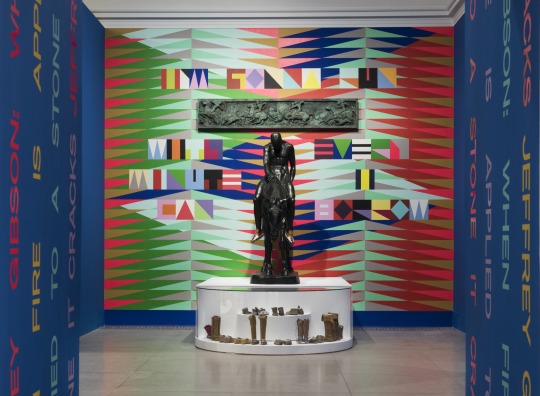
Jeffrey Gibson, an artist of Choctaw and Cherokee descent, incorporates elements of Native American art and craft into his practice, creating a rich visual and conceptual dialogue between his work and the histories that inform it. In our new exhibition Jeffrey Gibson: When Fire Is Applied to a Stone It Cracks, he selected objects from our collection, which are presented alongside his recent work. The resulting multimedia, floor-to-ceiling installation questions long-held institutional categorizations and representations of Indigenous peoples and Native American art. See it now through January 10, 2021.
Installation view by Jonathan Dorado
#jeffrey gibson#jeffreygibsonbkm#bkmartsofamericas#native american#native american art#choctaw#cherokee#art#artist#contemporary art#Indigenous peoples#installation#multimedia#art history#history#brooklyn museum#brooklyn
78 notes
·
View notes
Photo

Mix up a cocktail or mocktail and join us for another installment of Art History Happy Hour! Taking place on Facebook Live this Thursday at 6 pm, this edition focuses on Indigenous communities, art, and, activism. First, art historian and cofounder of The Indigenous Kinship Collective New York City (KIN) Regan de Loggans discusses the activist group’s recent direct actions, and how Black and Indigenous communities are organizing in solidarity with one another. Then, artist Jeffrey Gibson joins Jami Powell, Associate Curator of Native American Art at the Hood Museum of Art, for a conversation about his practice, working with museum collections, the place and meaning of monuments in both our exhibition Jeffrey Gibson: When Fire Is Applied to a Stone It Cracks and the broader public conversation, and the ongoing work of building collective futures. ⠀
⠀
To make the evening's suggested drink, created by mixologist Billy Green, you'll need:⠀
⠀
8 raspberries⠀
2 lime slices⠀
1/2 teaspoon sugar⠀
5 oz. cranberry juice⠀
4 oz. Perrier Strawberry (or Perrier Original)⠀
To make a cocktail: 2 oz. vodka⠀
⠀
In a cocktail shaker or large glass, muddle the raspberries with one lime slice and sugar. Add ice and cranberry juice, shake or stir until cold, and strain over a glass of ice. Top with Perrier Strawberry or Perrier Original and garnish with raspberries or a slice of lime.⠀
⠀
Sponsored by @PerrierUSA.
#jeffreygibsonbkm#arthistoryhappyhour#jeffrey gibson#jami powell#hood museum#monuments#indigenous#communities#art#activism#artivists#art history#regan de loggans#Indigenous Kinship Collective#solidarity#brooklyn museum
10 notes
·
View notes
Video
Join us this Saturday evening on Time Square Duffy Plaza for the premiere of artist Jeffrey Gibson’s Midnight Moment by Times Square Arts. The public performance begins at 11:30 pm and features performances by traditional song-carrier Joan Henry and acclaimed jingle dress dancer Sarah Ortegon. Presented with The Armory Show, Kavi Gupta, and Roberts Projects.
Then, see it every night in March at 11:57 pm! The artwork She Never Dances Alone celebrates the power of Indigenous women by transforming the performance of a single jingle dress dancer into a kaleidoscopic, ancestral call for strength and healing. New and recent work by Gibson is also on view in Jeffrey Gibson: When Fire Is Applied to a Stone It Cracks through January 10, 2021 here at the Museum.
Jeffrey Gibson, She Never Dances Alone (2019), excerpt courtesy of the artist 🎶 A Tribe Called Red, “Sisters,” excerpt courtesy of the artists. March 2020 Midnight Moment Exhibition presented by Times Square Arts with Brooklyn Museum.
#jeffrey gibson#times square arts#brooklyn museum#jeffreygibsonbkm#midnight moment#indigenous#women#strength#healing#jingle dress#dancer#kaleidoscopic#ancestral call
35 notes
·
View notes